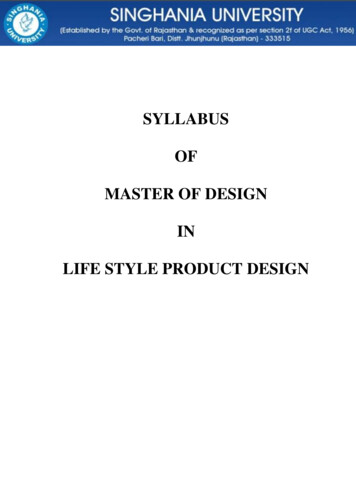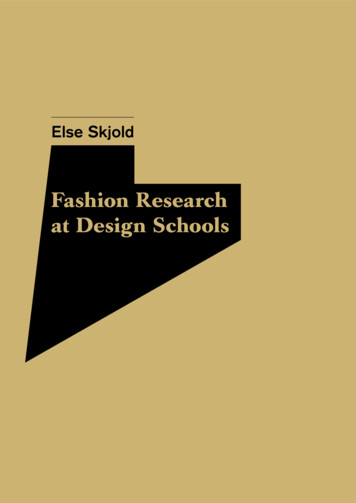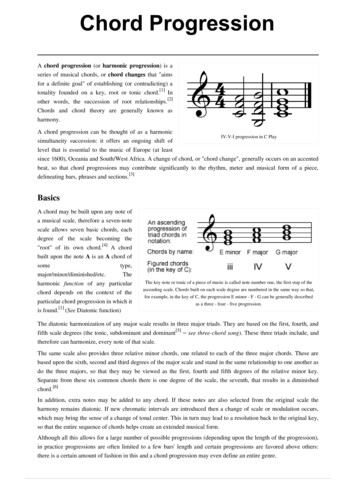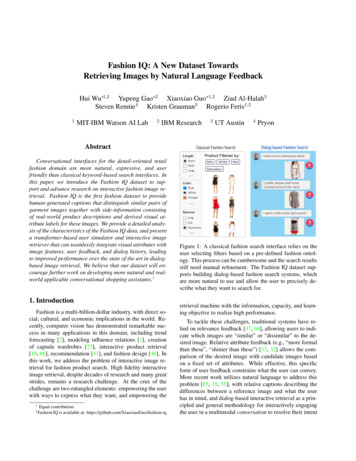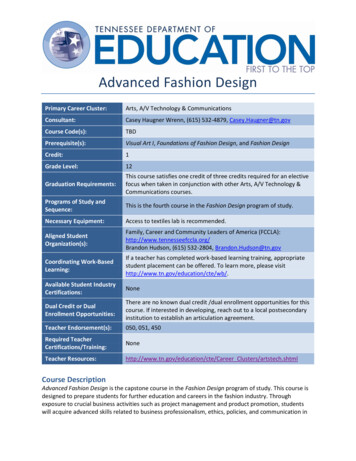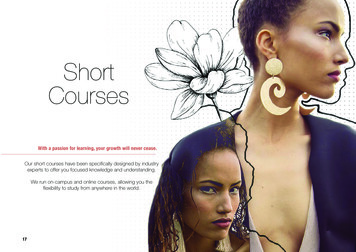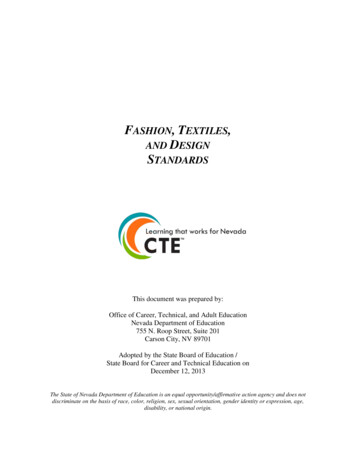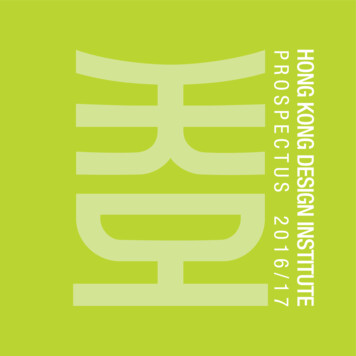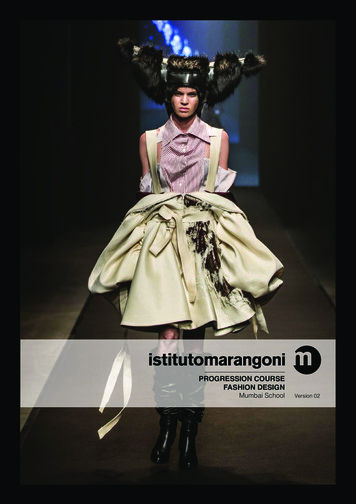
Transcription
PROGRESSION COURSEFASHION DESIGNMumbai SchoolVersion 02
Undergraduate ProgrammesProgression courseFashion Design02Brief Descriptive SummaryOver the past 80 years Istituto Marangoni has grown and developed alongside the thriving Italian fashion and design industry.Through an exciting curriculum aimed to develop practical, creative, and business and management skills which are subjectspecific, and relevant to the international fashion industry, Istituto Marangoni courses prepare participants in subjects such asFashion Design, Fashion Styling, Fashion Business and Interior Design.1. Certification attainedIstituto Marangoni CertificateCourse information2. Educational & Programme AimsEducation Aims:The educational aims are: to develop flexible approaches to programme delivery and participant support, which reflect the needs and expectations ofour learners; to provide a supportive and inclusive learning environment which enables success for all learners; to develop the students’ intellectual ability, creativity, independence, critical self-awareness, imagination and skills that enhanceglobal employment opportunities on completion from all courses; to establish a culture of constant improvement in learning, teaching and assessment that is anticipatory, enabling, supportive,rewarding and fully aligned with the Institutions vision and strategic objectives; to provide a learning experience that is informed by research, reflective practice and engagement within the fashion, designand creative industries.Programme Aims:The Fashion Design progressing course provides participants with the techniques to design and create menswear or womenswearcollections, while responding to changing needs in the international fashion and luxury industries. Fashion designers are theinspiration for creative ideas and new trends, not only in clothing, but also in fabric development. They create collections basedon an informed analysis of materials and fabrics in connection with art, design, creativity, and fashion. Starting with techniquesin fashion design and illustration, this course addresses the analysis of fabrics and clothing manufacturing, as well as the historyof dress, concluding with a final portfolio of work.3. Course Learning OutcomesInterim Learning Outcomes (ILO)Participants successfully completing the first block will have developed:ILO1 A basic understanding of the elements involved in the design process used in the fashion industry, and ability to developoriginal ideas for a fashion collection;ILO2 A fundamental knowledge of the context and structure of the fashion industry, in fashion garment construction techniques,and the overall design development process;ILO3 The ability to use appropriate research methods, and to take different approaches to problem solving;ILO4 The ability to communicate accurately, and compile and present coursework appropriate to the discipline.Programme Learning Outcomes (PLO)On successful completion of the course, participants will be able to:PLO1 Understand the process of fashion design and apply creative abilities, both intellectual and technical, used in thefashionindustry, or for further study in the area;PLO2 Apply current technologies in the development of creative ideas for a fashion collection;PLO3 Identify and analyse information from a variety of sources and formulate concepts to meet given criteria;PLO4 Apply a variety of drawing techniques and processes to communicate ideas;PLO5 Use pattern-making skills to construct innovative silhouettes and new details;PLO6 Identify, evaluate and use information from a variety of sources in order to understand key cultural, social and environmentalinfluences in fashion.
Undergraduate ProgrammesProgression courseFashion Design034. Teaching/Learning and Assessment StrategyCurriculum:Structured in two distinct ‘blocks’, participants can choose when to build on their experience by progressing from one blockto another, giving them complete control on their own progress and achievement. On successful completion of both levelsparticipants gain a solid base in fashion design and garment construction to enable them to enter the industry, or to progressfurther in their studies to a higher level of comprehension and skill. The course is aimed at candidates who have the ambition tobecome professional fashion designers, or who are looking to enter the fashion design and creative industries.Fashion design 1 (24 weeks)The first part of the programme starts with an overview of sketching and drawing techniques, pattern cutting basics, and theprinciples of art and costume. Focus is made on exploring and building a design style, driven by contemporary approachesto the subject area. The course focuses on the design of the product with introductory drawing and garment making skills, inorder to help participants achieve a solid base in fashion design. Participants then move on to acquiring and developing skillsto design collections, based on an informed analysis of proportion, the relationship between art and design, fabrics, garmentconstruction and the marketing of ideas. They concentrate on how to analyse body proportions in detail, discuss the ties betweenart and design, and become familiar with fabric, garment making and concept communication so as to achieve proficiency infashion collection design and development.Fashion design 2 (24 weeks)This second and final phase of the programme further progresses in collection design, where participants fully elaborate the detaileddevelopment of a collection. They look into fabric dying and printing, as well as finishing techniques and learn visual communicationskills necessary to present and explain their individual inspiration and style approach. They work on a final collection of designs,relevant to a realistic and contemporary design brief. The project results are demonstrated in an individual fashion collectionportfolio that participants can present to eventual prospective employers.OpportunitiesAt the end of the programme (2 blocks) participants will have gained key skills in fashion design to be able to enter into theworking world. Fashion designers can work for private labels or in collaboration with national and international fashion housesand style studios, designing collections for womenswear and menswear, while keeping an eye on new evolutions in fashiondesign.Progressing Abroad – European Study OptionsParticipants attending the undergraduate Progressing Courses in Mumbai have the opportunity to further excel in design,creativity and research, by completing their study pathway at one of Istituto Marangoni’s schools in Milano or Firenze (Italy). Onsuccessful completion of that programme they will be awarded the 3-year Undergraduate Diploma from the European school.Assessment:Formative Assessments:This consists in a daily interaction with the tutors that through feedback help the participants to adopt a critical appraisal of their ownlearning experience, and helps them assess their own performance in relation to the learning outcomes set for each element of study.Summative Assessments:These are formal assessments and are a means of gauging participant learning, at a particular point in time, relative to establishedmarking criteria (Learning Outcomes). Summative assessments can occur during as well as at the end of each unit on specificevidence of participant work, examples as follows:Portfolio Assessment is used to assess a variety of projects that have been developed throughout the unit and contained withina single folder or portfolio. Portfolio assessment could take a variety of formats depending on the subject and stipulated by the tutor.Practical and class-based projects allow participants to apply their theoretical understanding of a specific subject area.Written Reports are required in some study areas and these in some cases are a response to industry briefs, allowingparticipants to reflect real industry requirements and to present work to industry standards through report writing.Presentations are used in some subjects to allow participants to develop their creative, professional communicationand presentation skills, formalising their arguments in a critical manner. When giving presentations participants are activelyencouraged to embrace new technologies and media in an innovative way where appropriate.
Undergraduate ProgrammesProgression courseFashion Design04Marking systemUndergraduate Progression courses have these grade thresholds:MarkOutcomeDescriptor (to achieve the banding on the left)0-29FailInsufficient / poorMarginal fail - most unit learning outcomes achieved at threshold level30-39FailInsufficient / poorMarginal fail - most unit learning outcomes achieved at threshold level40-49PassAcceptable / adequateCriteria have been met at a minimum level50-59PassFairly goodAdequate criteria have been met as directed in the brief, a basic understanding demonstrated60-69PassGood/strongAdequate criteria have been met as directed in the brief; a developed understanding has beendemonstrated in a well-structured manner 70PassExcellent / outstanding / exceptionalA demonstration of additional ideas and approach expanding on those directed in the brief. Highlevel of understanding and creativity5 Course structureBlock 1 Duration: 24 weeksCore UnitsCodeStatusUnit TitleFICoreFashion IllustrationDVCoreDesign VisionBlock 2 Duration: 24 weeksCore UnitsCodeStatusUnit TitleCCCoreCut & ConstructionGPCoreFinal Project(Progressing to Europe only) Duration: 6 weeksCore UnitsCodeStatusUnit TitleCSAWCoreCultural Studies & Academic Writing6. Technology Enhanced LearningSinaptoIstituto Marangoni uses Sinapto, a virtual space to share knowledge and helps manage and communicate the process of teachingand learning, and communicates participant progression. It is also used for tutors to organise, manage and deliver course materialsmaking it available to participants throughout their courses to facilitate their learning and assessment experience. At the beginning of thecourse, all participants receive their login details to access Sinapto, a participant-learning environment designed for Istituto Marangoni.Through Sinapto, participants on all schools and away from school are able to access and download the latest documents, formsand templates such as:1. Student Handbook;2. Unit Handbook / Programme Handbook;3. Unit weekly hand-outs;4. Calendar;5. Lessons and assessment timetable.
Undergraduate ProgrammesProgression courseFashion Design05Participants are asked to access the Student Voice via Qualtrics in order to leave feedback; any issues can also be addressedvia the ‘raise an issue’ application, which is also found in Sinapto. Both participants and staff can view grades and assessmentfeedback. Sinapto is updated annually across the schools and is an important tool for the staff of Istituto Marangoni to use forprogramme development and to develop further employability strategies for participants. In addition to Sinapto, a group widemobile application has been developed and launched in 2018. This application has a wide range of user-friendly functions andallows participants to interact with each other.Sinapto can be accessed remotely both by participants and staff, on and off-site.7. Personal Development PlanningPDP/Individual Development TutorialThe Director of Education and the Academic Service support the personal development of participants. One-to-one appointmentsmay be made by phone, through the receptionists or by email. Participants can expect to be seen almost immediately to discussany issues they may have.8. Tutor ResponsibilitiesThe Director of Education has the responsibility for implementing the strategic direction of the courses and the co-ordination ofthe academic teams and administration, necessary for the successful day-to-day operation of the school.The Tutors’ responsibilities include:1. all matters pertinent to the proper day-to-day operation of the programme involving leading and supporting participants;2. advice to the Director of Education on appropriate delivery for the continuing development of the programme;3. recommendations in areas for curriculum development;4. liaison with the Student Support Officer to ensure appropriate study support is available to participants;5. recommendation of the appropriate level of resource required for the Unit;6. maintaining the quality of educational standards.9. Student Support StrategyIstituto Marangoni’s departmental policies ensure that various mechanisms are in place to enhance the participant experience,in a pedagogic, practical and pastoral way:a. programme handbooks provide relevant information to participants;b. the use of the Library, online resources (where available), and the centre facilities help participants to reach the skills andknowledge expected on the course;c. Tutors and the Director of Education guide participants to the most appropriate help.Student Support OfficersIstituto Marangoni provides Faculty Student Support Officers, who act as the first point of contact for participants for pedagogicalcounselling.For matters of pastoral care the Student Support Officers help in:- finding their way around;- managing their time;- dealing with stress;- exam tips;- getting the best from their course;- understanding and applying the School’s rules;- anything else the officers can advise on.One-to-one appointments may be made by phone, through the receptionists or by email. Where possible participants can expectto be seen almost immediately, or contacted to arrange a suitable time.10. Student FeedbackParticipant feedback is essential to programme development and participant comments are used to enhance both the successfulmanagement of the programme and the teaching/learning strategies.Istituto Marangoni gathers participant opinion in a variety of ways, which may include the following: informal contact with the Tutor, and through appointments with academic staff; end of course online questionnaires where participants are invited to reflect on their overall experience at the School.It would be desirable that students provide details of their identity when giving constructive feedback on the course and teachingmethods. There might be occasions when that is not appropriate and Istituto Marangoni recognises such exceptions. In theseinstances, the programme teams and central support services will ensure that anonymity and confidentiality are respected.
become professional fashion designers, or who are looking to enter the fashion design and creative industries. Fashion design 1 (24 weeks) The first part of the programme starts with an overview of sketching and drawing techniques, pattern cutting basics, and the principles of art and costume. Focus is made on exploring and building a design .
